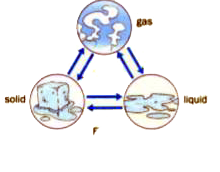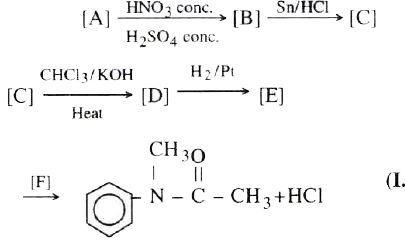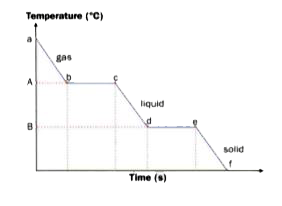What is inter-conversion of matter. Give the meaning of the terms involved in inter-conversion of matter -
a] Melting
b] Vaporisation
c) Liquefaction or condensation
d] Solidification or freezing
e] Sublimation
Step-by-Step Text Solution:
Inter-conversion of Matter:
Inter-conversion of matter refers to the processes through which matter changes from one state to another. This includes the transformation of solids to liquids, liquids to gases, gases to liquids, and solids to gases, as well as the reverse processes.
1. Melting:
- Definition: Melting is the process in which a solid turns into a liquid.
- Example: Ice melting into water when heated.
2. Vaporization:
- Definition: Vaporization is the process in which a liquid converts into a gas.
- Example: Water boiling and turning into steam.
3. Liquefaction or Condensation:
- Definition: Liquefaction or condensation is the process in which a gas converts into a liquid.
- Example: Water vapor condensing into liquid water on a cold surface.
4. Solidification or Freezing:
- Definition: Solidification or freezing is the process in which a liquid turns into a solid.
- Example: Water freezing into ice when the temperature drops.
5. Sublimation:
- Definition: Sublimation is the process in which a solid directly converts into a gas without becoming a liquid, or vice versa, where a gas converts directly into a solid.
- Example: Dry ice (solid carbon dioxide) sublimating into carbon dioxide gas.
Summary:
Inter-conversion of matter includes five main processes: melting (solid to liquid), vaporization (liquid to gas), liquefaction or condensation (gas to liquid), solidification or freezing (liquid to solid), and sublimation (solid to gas or gas to solid).
---
Inter-conversion of matter refers to the processes through which matter changes from one state to another. This includes the transformation of solids to liquids, liquids to gases, gases to liquids, and solids to gases, as well as the reverse processes.
- Definition: Melting is the process in which a solid turns into a liquid.
- Example: Ice melting into water when heated.
- Definition: Vaporization is the process in which a liquid converts into a gas.
- Example: Water boiling and turning into steam.
- Definition: Liquefaction or condensation is the process in which a gas converts into a liquid.
- Example: Water vapor condensing into liquid water on a cold surface.
- Definition: Solidification or freezing is the process in which a liquid turns into a solid.
- Example: Water freezing into ice when the temperature drops.
- Definition: Sublimation is the process in which a solid directly converts into a gas without becoming a liquid, or vice versa, where a gas converts directly into a solid.
- Example: Dry ice (solid carbon dioxide) sublimating into carbon dioxide gas.
Inter-conversion of matter includes five main processes: melting (solid to liquid), vaporization (liquid to gas), liquefaction or condensation (gas to liquid), solidification or freezing (liquid to solid), and sublimation (solid to gas or gas to solid).
Topper's Solved these Questions
- MATTERBOOK - ICSECHAPTER - MATTEREXERCISE - OBJECTIVE TYPE QUESTIONS
21 Videos
- MATTERBOOK - ICSECHAPTER - MATTEREXERCISE - Test Yourself - 1 ( Fill in the blanks )
5 Videos
- MATTERBOOK - ICSECHAPTER - MATTEREXERCISE - Think and answer
7 Videos
- LANGUAGE OF CHEMISTRY BOOK - ICSECHAPTER - LANGUAGE OF CHEMISTRY EXERCISE - Exercise (Balance the following equations)
4 Videos
- PHYSICAL & CHEMICAL CHANGESBOOK - ICSECHAPTER - PHYSICAL & CHEMICAL CHANGESEXERCISE - OBJECTIVE TYPE QUESTIONS (Physical & Chemical Changes)
21 Videos
Similar Questions
State which of the following terms connected with change of state of matter i.e. -
a] Melting b] Vaporisation c] Condensation d] Freezing - pertain to -
(i] Conversion of a liquid into a vapour or gas
[ii] Conversion of a liquid into a solid.
[iii] Conversion of a solid into a liquid on heating.
View SolutionWith reference to inter-conversion of matter - on the basis of kinetic theory - explain in brief the conversion of:
A solid into a liquid
With special reference to inter-particle space & inter-particle attraction at the different stages of conversion
View SolutionWith reference to inter-conversion of matter - on the basis of kinetic theory - explain in brief the conversion of:
Vapour (or gas) into a liquid
With special reference to inter-particle space & inter-particle attraction at the different stages of conversion
View SolutionWith reference to inter-conversion of matter - on the basis of kinetic theory - explain in brief the conversion of:
A liquid into a solid
With special reference to inter-particle space & inter-particle attraction at the different stages of conversion
View SolutionFigure A shows the change of states of matter. In it, add the following words: deposition, condensation, melting, sublimation, freezing, and evaporation.

View SolutionGive balanced equations for the following conversions -A,B,C,D&E.

View SolutionWith reference to inter-conversion of matter - on the basis of kinetic theory - explain in brief the conversion of:
A liquid into vapour (or gas)
With special reference to inter-particle space & inter-particle attraction at the different stages of conversion
View Solution(a) Conversion of solid of vapour is called sublimation . Name the term used to denote the conversion of vapour to solid.
(b) Conversion of solid state to liquid is called fusion, what is meant by latent heat of fusion?
View SolutionGive the name and formula of each A, B, C, D, E and F in the following conversion reactions :

View SolutionLook at the change of state diagram from gas to solid given here carefully, and answer the following questions.
a. During freezing, certain amount of heat is given out without any change in temperature. Which part of the graph shows this change?
b. During condensation, certain amount of heat is given out without any change in temperature. Which part of the graph shows this change?
c. Which point on the graph corresponds to
İ. condensation point? ii. freezing point?
d. What do ab and cd on the graph represent?

View Solution
